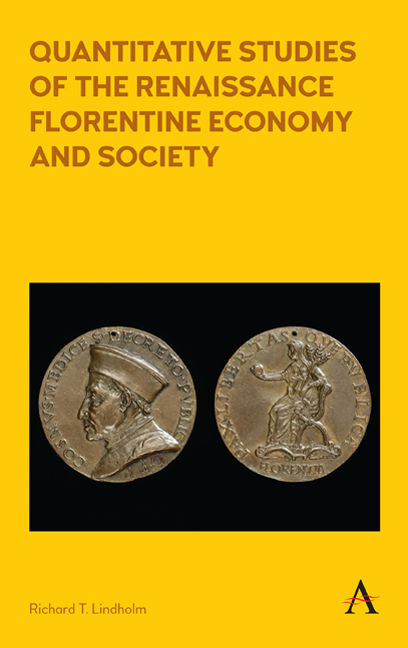Book contents
- Frontmatter
- Dedication
- Contents
- List of Illustrations
- Preface
- Acknowledgments
- List of Abbreviations
- Introduction
- Part I RISKS AND RETURNS
- Part II SOCIETY
- Part III WORK
- Chapter Seven Just Doing Business: Testing Competition in the Renaissance Florentine Wool Industry
- Chapter Eight Time for It All: Women in the Renaissance Florentine Wool Industry
- Chapter Nine Why Were Renaissance Florentine Wool Industry Companies So Small?
- Conclusion
- Glossary
- Bibliography
- Index
Chapter Seven - Just Doing Business: Testing Competition in the Renaissance Florentine Wool Industry
from Part III - WORK
Published online by Cambridge University Press: 10 January 2018
- Frontmatter
- Dedication
- Contents
- List of Illustrations
- Preface
- Acknowledgments
- List of Abbreviations
- Introduction
- Part I RISKS AND RETURNS
- Part II SOCIETY
- Part III WORK
- Chapter Seven Just Doing Business: Testing Competition in the Renaissance Florentine Wool Industry
- Chapter Eight Time for It All: Women in the Renaissance Florentine Wool Industry
- Chapter Nine Why Were Renaissance Florentine Wool Industry Companies So Small?
- Conclusion
- Glossary
- Bibliography
- Index
Summary
Introduction
The organization and efficiency of Florentine business is a key question in the study of the Renaissance. The city's businesses made the money that paid for the art and architecture of the Florentine Renaissance. Views of Florentine economic efficiency are widely split. Whether or not the industry was competitive has important implications about how one views the Florentine economy. Markets can range fromcompetitive through gradations of monopsony power to simple monopolies. Florentine wool industry firms operated in two markets: an input market and an output market. These were distinct. A competitive industry has a number of implications besides not being a monopoly. There is a type of equality among the firms. No firm or subset of firms dominates or leads the industry or has a significant influence on prices. Economists would call these firms price takers. They accept the prices as they are on the market and are unable to change them. This implies that production is efficient and that the owners do not receive any economic rent, excessive profits. A competitive industry also has implications for society. It both allocates resources efficiently and prevents extraction by the rich from the poor. Since Florentine businesses were essentially family proprietorships, a competitive industry would imply that the marketplace was fair.
A competitive market does not imply that the guild was meaningless. However, it is important to be careful in defining the market. Organizations that possess monopoly power that have individual members without monopoly power are common in today's world. For example, a seat on a stock exchange is expensive and membership is limited. Exchange membership is valuable because only members can buy and sell stocks directly. Nevertheless, the stock markets are competitive.
An analysis of competition in the Renaissance Florence wool industry is presented in the rest of this chapter. Both the source and the method largely drive the results from previous studies of Florentine competitiveness. Further, methods that ignore the dynamic nature of economies seem more likely to find a less competitive business environment. From this foundation, two methods are used to examine competitiveness in the Florentine wool industry. It describes the theory, specifies the tests and presents the findings of these two approaches together.
- Type
- Chapter
- Information
- Publisher: Anthem PressPrint publication year: 2017



